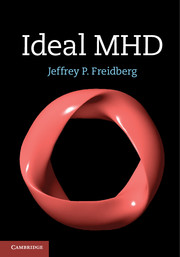Book contents
- Frontmatter
- Dedication
- Contents
- Preface
- Acknowledgements
- 1 Introduction
- 2 The ideal MHD model
- 3 General properties of ideal MHD
- 4 MHD equilibrium: general considerations
- 5 Equilibrium: one-dimensional configurations
- 6 Equilibrium: two-dimensional configurations
- 7 Equilibrium: three-dimensional configurations
- 8 MHD stability – general considerations
- 9 Alternate MHD models
- 10 MHD stability comparison theorems
- 11 Stability: one-dimensional configurations
- 12 Stability: multi-dimensional configurations
- Appendix A Heuristic derivation of the kinetic equation
- Appendix B The Braginskii transport coefficients
- Appendix C Time derivatives in moving plasmas
- Appendix D The curvature vector
- Appendix E Overlap limit of the high β and Greene–Johnson stellarator models
- Appendix F General form for q(ψ)
- Appendix G Natural boundary conditions
- Appendix H Upper and lower bounds on δQKIN
- Index
- References
9 - Alternate MHD models
Published online by Cambridge University Press: 05 July 2014
- Frontmatter
- Dedication
- Contents
- Preface
- Acknowledgements
- 1 Introduction
- 2 The ideal MHD model
- 3 General properties of ideal MHD
- 4 MHD equilibrium: general considerations
- 5 Equilibrium: one-dimensional configurations
- 6 Equilibrium: two-dimensional configurations
- 7 Equilibrium: three-dimensional configurations
- 8 MHD stability – general considerations
- 9 Alternate MHD models
- 10 MHD stability comparison theorems
- 11 Stability: one-dimensional configurations
- 12 Stability: multi-dimensional configurations
- Appendix A Heuristic derivation of the kinetic equation
- Appendix B The Braginskii transport coefficients
- Appendix C Time derivatives in moving plasmas
- Appendix D The curvature vector
- Appendix E Overlap limit of the high β and Greene–Johnson stellarator models
- Appendix F General form for q(ψ)
- Appendix G Natural boundary conditions
- Appendix H Upper and lower bounds on δQKIN
- Index
- References
Summary
Introduction
Ideal MHD is the simplest model that describes the macroscopic equilibrium and stability of high-temperature fusion plasmas. A self-consistent derivation of the model has been presented in Chapter 2. The derivation requires that one restrict attention to the MHD length and time scales. The main assumptions for validity of ideal MHD are (1) small ion gyro radius, (2) high collisionality, and (3) negligible resistive diffusion. As pointed out, the high collisionality assumption is never satisfied in fusion-grade plasmas, which makes it perhaps surprising how accurate and reliable the model is in predicting experimental behavior.
The goal of Chapter 9 is to begin to address this unsettling situation. While there are a number of alternate MHD models in various regimes of collisionality, the strategy here is to focus on two specific models that describe MHD behavior in the collisionless regime. These are the models that are most relevant to fusion plasmas. Ultimately, in Chapter 10 a set of general stability “comparison theorems” is derived that enables one to make quantitative comparisons between the predictions of the collision dominated and collisionless models. The present chapter, however, focuses solely upon the introduction of the two alternate models. Also presented is a review of ideal MHD which serves as a reference. The specific models discussed are as follows:
Ideal MHD: collision dominated fluid
Kinetic MHD: collisionless kinetic plasma
Double adiabatic theory: collisionless fluid.
- Type
- Chapter
- Information
- Ideal MHD , pp. 381 - 399Publisher: Cambridge University PressPrint publication year: 2014



